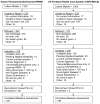Higher Prescription Opioid Dose is Associated With Worse Patient-Reported Pain Outcomes and More Health Care Utilization
- PMID: 27993558
- PMCID: PMC5376359
- DOI: 10.1016/j.jpain.2016.12.004
Higher Prescription Opioid Dose is Associated With Worse Patient-Reported Pain Outcomes and More Health Care Utilization
Abstract
Some previous research has examined pain-related variables on the basis of prescription opioid dose, but data from studies involving patient-reported outcomes have been limited. This study examined the relationships between prescription opioid dose and self-reported pain intensity, function, quality of life, and mental health. Participants were recruited from 2 large integrated health systems, Kaiser Permanente Northwest (n = 331) and VA Portland Health Care System (n = 186). To be included, participants had to have musculoskeletal pain diagnoses and be receiving stable doses of long-term opioid therapy. We divided participants into 3 groups on the basis of current prescription opioid dose in daily morphine equivalent dose (MED): low dose (5-20 mg MED), moderate dose (20.1-50 mg MED), and higher dose (50.1-120 mg MED) groups. A statistically significant trend emerged where higher prescription opioid dose was associated with moderately sized effects including greater pain intensity, more impairments in functioning and quality of life, poorer self-efficacy for managing pain, greater fear avoidance, and more health care utilization. Rates of potential alcohol and substance use disorders also differed among groups. Findings from this evaluation reveal significant differences in pain-related and substance-related factors on the basis of prescription opioid dose.
Perspective: This study included 517 patients who were prescribed long-term opioid therapy and compared differences on pain- and mental health-related variables on the basis of prescription opioid dose. Findings reveal small- to medium-sized differences on pain-related variables, alcohol and substance use, and health care utilization on the basis of the dose of opioid prescribed.
Keywords: Musculoskeletal pain; chronic pain; opioids.
Published by Elsevier Inc.
References
-
- Adams LL, Gatchel RJ, Robinson RC, Polatin P, Gajaraj N, Deschner M, Noe C. Development of a self-report screening instrument for assessing potential opioid medication misuse in chronic pain patients. J Pain Symptom Manage. 2004;27:440–459. - PubMed
-
- Ballantyne JC, Mao J. Opioid therapy for chronic pain. N Engl J Med. 2003;349:1943–1953. - PubMed
-
- Bohnert AS, Bonar EE, Cunningham R, Greenwald MK, Thomas L, Chermack S, Blow FC, Walton M. A pilot randomized clinical trial of an intervention to reduce overdose risk behaviors among emergency department patients at risk for prescription opioid overdose. Drug Alcohol Depend. 2016;163:40–47. - PubMed
Publication types
MeSH terms
Substances
Grants and funding
LinkOut - more resources
Full Text Sources
Other Literature Sources
Medical


